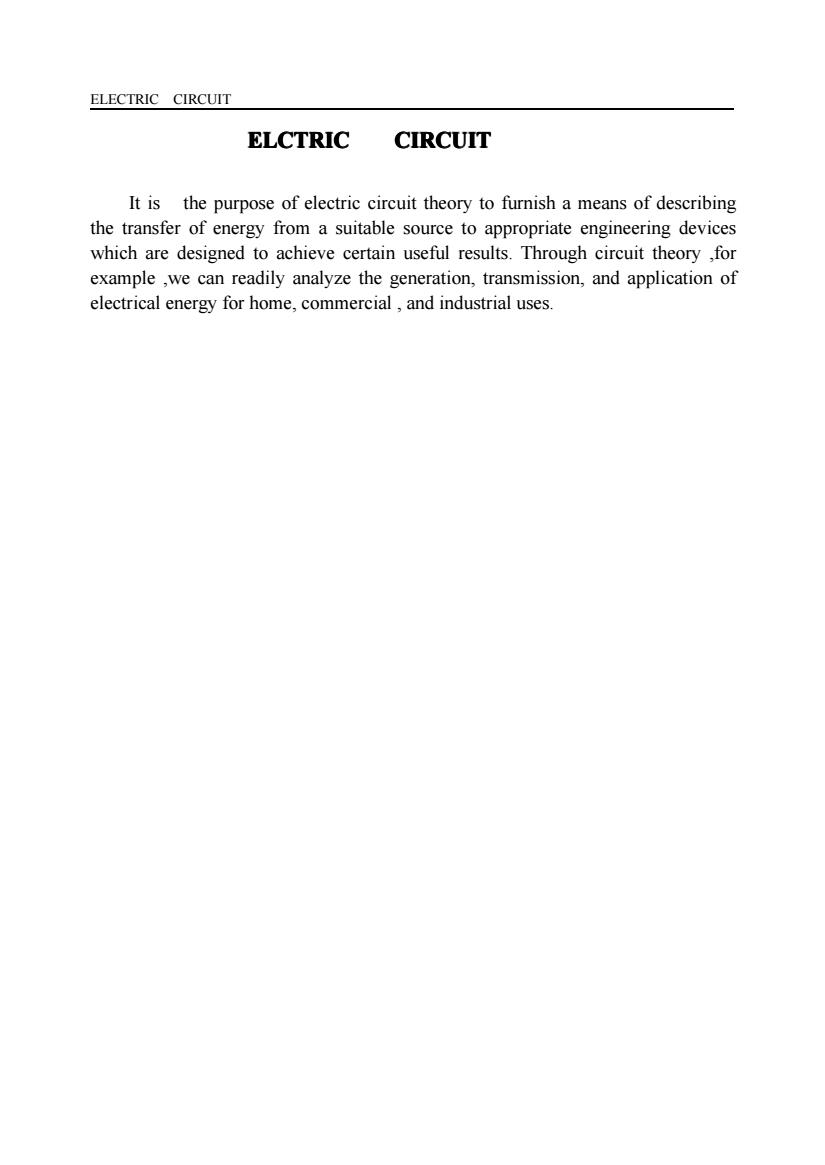
ELECTRIC CIRCUIT ELCTRIC CIRCUIT It is the purpose of electric circuit theory to furnish a means of describing the transfer of energy from a suitable source to appropriate engineering devices which are designed to achieve certain useful results.Through circuit theory ,for example ,we can readily analyze the generation,transmission,and application of electrical energy for home,commercial,and industrial uses
ELECTRIC CIRCUIT ELCTRIC ELCTRIC ELCTRIC ELCTRIC CIRCUIT CIRCUIT CIRCUIT CIRCUIT It is the purpose of electric circuit theory to furnish a means of describing the transfer of energy from a suitable source to appropriate engineering devices which are designed to achieve certain useful results. Through circuit theory ,for example ,we can readily analyze the generation, transmission, and application of electrical energy for home, commercial , and industrial uses
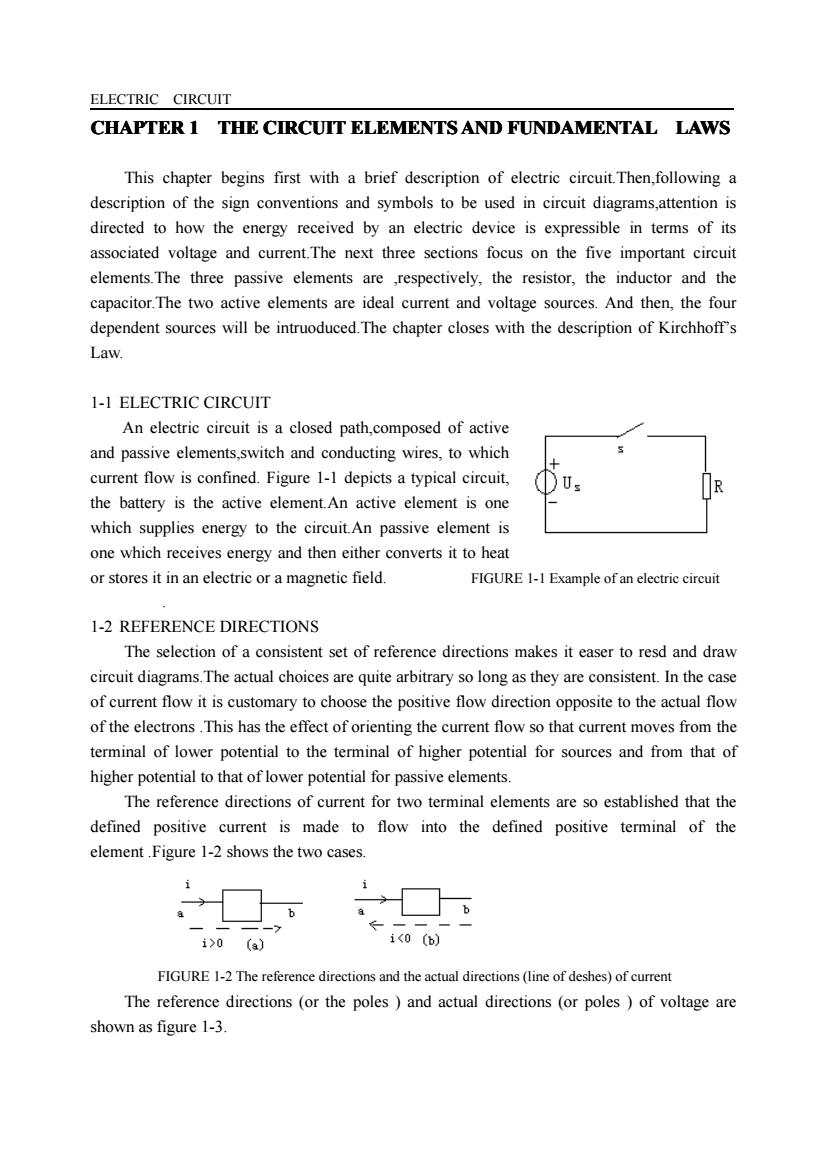
ELECTRIC CIRCUIT CHAPTER1 THE CIRCUIT ELEMENTS AND FUNDAMENTAL LAWS This chapter begins first with a brief description of electric circuit. Then, following a description of the sign conventions and symbols to be used in circuit diagrams,attention is directed to how the energy received by an electric device is expressible in terms of its associated voltage and current. The next three sections focus on the five important circuit elements. The three passive elements are ,respectively, the resistor, the inductor and the capacitor. The two active elements are ideal current and voltage sources. And then, the four dependent sources will be intruoduced. The chapter closes with the description of Kirchhoff's Law. 1-1 ELECTRIC CIRCUIT An electric circuit is a closed path,composed of active and passive elements,switch and conducting wires, to which + current flow is confined. Figure 1-1 depicts a typical circuit, Us R the battery is the active element. An active element is one which supplies energy to the circuit.An passive element is one which receives energy and then either converts it to heat or stores it in an electric or a magnetic field. FIGURE 1-1 Example of an electric circuit 1-2 REFERENCE DIRECTIONS The selection of a consistent set of reference directions makes it easer to resd and draw circuit diagrams. The actual choices are quite arbitrary so long as they are consistent. In the case of current flow it is customary to choose the positive flow direction opposite to the actual flow of the electrons. This has the effect of orienting the current flow so that current moves from the terminal of lower potential to the terminal of higher potential for sources and from that of higher potential to that of lower potential for passive elements. The reference directions of current for two terminal elements are so established that the defined positive current is made to flow into the defined positive terminal of the element. Figure 1-2 shows the two cases. i i → a b a b i>0 (a) i<0(b) FIGURE 1-2 The reference directions and the actual directions (line of deshes) of current The reference directions (or the poles)and actual directions (or poles)of voltage are shown as figure 1-3
ELECTRIC CIRCUIT CHAPTER CHAPTER CHAPTER CHAPTER 1 THE CIRCUIT CIRCUIT CIRCUIT CIRCUIT ELEMENTS ELEMENTS ELEMENTS ELEMENTS AND FUNDAMENTAL FUNDAMENTAL FUNDAMENTAL FUNDAMENTAL LAWS This chapter begins first with a brief description of electric circuit.Then,following a description of the sign conventions and symbols to be used in circuit diagrams,attention is directed to how the energy received by an electric device is expressible in terms of its associated voltage and current.The next three sections focus on the five important circuit elements.The three passive elements are ,respectively, the resistor, the inductor and the capacitor.The two active elements are ideal current and voltage sources. And then, the four dependent sources will be intruoduced.The chapter closes with the description of Kirchhoff’s Law. 1-1 ELECTRIC CIRCUIT An electric circuit is a closed path,composed of active and passive elements,switch and conducting wires, to which current flow is confined. Figure 1-1 depicts a typical circuit, the battery is the active element.An active element is one which supplies energy to the circuit.An passive element is one which receives energy and then either converts it to heat or stores it in an electric or a magnetic field. FIGURE 1-1 Example of an electric circuit . 1-2 REFERENCE DIRECTIONS The selection of a consistent set of reference directions makes it easer to resd and draw circuit diagrams.The actual choices are quite arbitrary so long as they are consistent. In the case of current flow it is customary to choose the positive flow direction opposite to the actual flow of the electrons .This has the effect of orienting the current flow so that current moves from the terminal of lower potential to the terminal of higher potential for sources and from that of higher potential to that of lower potential for passive elements. The reference directions of current for two terminal elements are so established that the defined positive current is made to flow into the defined positive terminal of the element .Figure 1-2 shows the two cases. FIGURE 1-2 The reference directions and the actual directions (line of deshes) of current The reference directions (or the poles ) and actual directions (or poles ) of voltage are shown as figure 1-3
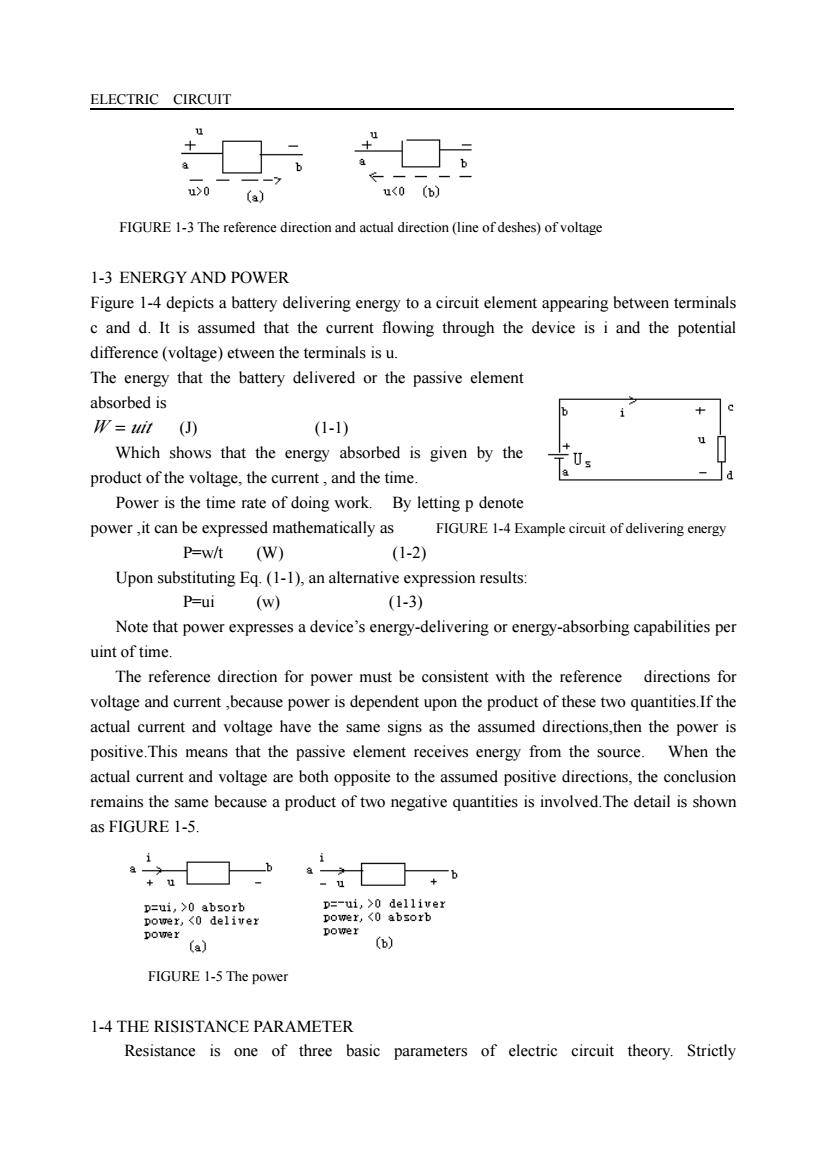
ELECTRIC CIRCUIT u>o (a) u<0) FIGURE 1-3The reference direction and actual direction(line of deshes)of voltage 13 EneRGYAND POWER Figure 1-4 depicts a battery delivering energy to a circuit element appearing between terminals c and d.It is assumed that the current flowing through the device is i and the potential difference(voltage)etween the terminals is u The energy that the battery delivered or the passive element absorbed is 6 f=() (1-1) Which shows that the energy absorbed is given by the product of the voltage,the current,and the time. . Power is the time rate of doing work.By letting p denote power,it can be expressed mathematically as FIGURE 1-4 Example circuit of delivering energy P=w/t (w) (1-2) Upon substituting Eq.(1-1),an alternative expression results P-ui (w) (1-3) Note that power expresses a device's energy-delivering or energy-absorbing capabilities per uint of time The reference direction for power must be consistent with the reference directions for voltage and current,because power is dependent upon the product of these two quantities.If the actual current and voltage have the same signs as the assumed directions,then the power is positive.This means that the passive element receives energy from the source.When the actual current and voltage are both opposite to the assumed positive directions,the conclusion remains the same because a product of two negative quantities is involved.The detail is shown as FIGURE 1-5. 0 器8 () FIGURE 1-5 The power 1-4 THE RISISTANCE PARAMETER Resistance is one of three basic parameters of electric circuit theory.Strictly
ELECTRIC CIRCUIT FIGURE 1-3 The reference direction and actual direction (line of deshes) of voltage 1-3 ENERGY AND POWER Figure 1-4 depicts a battery delivering energy to a circuit element appearing between terminals c and d. It is assumed that the current flowing through the device is i and the potential difference (voltage) etween the terminals is u. The energy that the battery delivered or the passive element absorbed is W = uit (J) (1-1) Which shows that the energy absorbed is given by the product of the voltage, the current , and the time. Power is the time rate of doing work. By letting p denote power ,it can be expressed mathematically as FIGURE 1-4 Example circuit of delivering energy P=w/t (W) (1-2) Upon substituting Eq. (1-1), an alternative expression results: P=ui (w) (1-3) Note that power expresses a device’s energy-delivering or energy-absorbing capabilities per uint of time. The reference direction for power must be consistent with the reference directions for voltage and current ,because power is dependent upon the product of these two quantities.If the actual current and voltage have the same signs as the assumed directions,then the power is positive.This means that the passive element receives energy from the source. When the actual current and voltage are both opposite to the assumed positive directions, the conclusion remains the same because a product of two negative quantities is involved.The detail is shown as FIGURE 1-5. FIGURE 1-5 The power 1-4 THE RISISTANCE PARAMETER Resistance is one of three basic parameters of electric circuit theory. Strictly
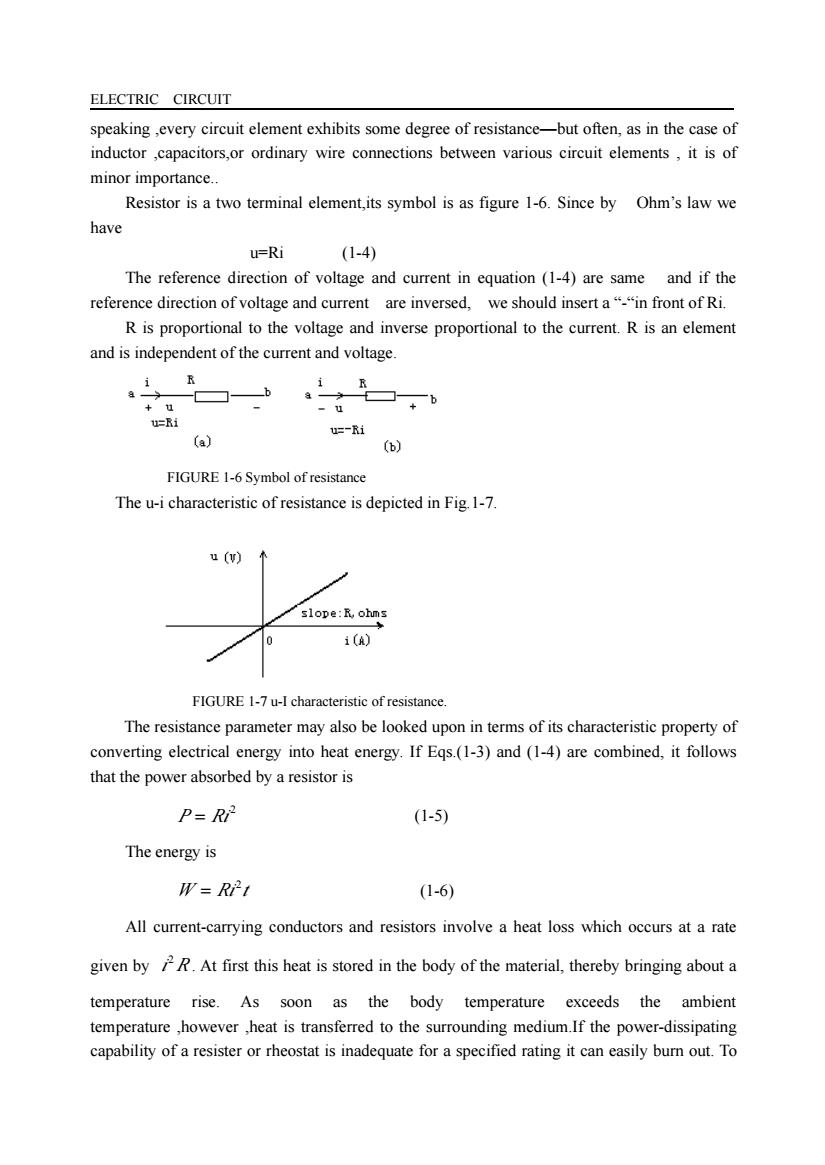
ELECTRIC CIRCUIT speaking ,every circuit element exhibits some degree of resistance-but often,as in the case of inductor,capacitors,or ordinary wire connections between various circuit elements,it is of minor importance. Resistor is a two terminal element,its symbol is as figure 1-6.Since by Ohm's law we have U=Ri (1-4) The reference direction of voltage and current in equation(1-4)are same and if the reference direction of voltage and current are inversed,we should insert a""in front of Ri. R is proportional to the voltage and inverse proportional to the current.R is an element and is independent of the current and voltage. =-1 (a) FIGURE 1-6 Symbol of resistance The u-i characteristic of resistance is depicted in Fig 1-7. u() slope:R ohms /0 (A) FIGURE 1-7u-I characteristic of resistance. The resistance parameter may also be looked upon in terms of its characteristic property of converting electrical energy into heat energy.If Eqs.(1-3)and(1-4)are combined,it follows that the power absorbed by a resistor is P=Ri (1-5) The energy is m=R21 (1-6) All current-carrying conductors and resistors involve a heat loss which occurs at a rate given by.At first this heat is stored in the body of the material,thereby bringing about a temperature rise.As soon as the body temperature exceeds the ambient temperature ,however ,heat is transferred to the surrounding medium.If the power-dissipating capability of a resister or rheostat is inadequate for a specified rating it can easily bur out.To
ELECTRIC CIRCUIT speaking ,every circuit element exhibits some degree of resistance—but often, as in the case of inductor ,capacitors,or ordinary wire connections between various circuit elements , it is of minor importance. Resistor is a two terminal element,its symbol is as figure 1-6. Since by Ohm’s law we have u=Ri (1-4) The reference direction of voltage and current in equation (1-4) are same and if the reference direction of voltage and current are inversed, we should insert a “-“in front of Ri. R is proportional to the voltage and inverse proportional to the current. R is an element and is independent of the current and voltage. FIGURE 1-6 Symbol of resistance The u-i characteristic of resistance is depicted in Fig.1-7. FIGURE 1-7 u-I characteristic of resistance. The resistance parameter may also be looked upon in terms of its characteristic property of converting electrical energy into heat energy. If Eqs.(1-3) and (1-4) are combined, it follows that the power absorbed by a resistor is 2 P = Ri (1-5) The energy is W Ri t 2 = (1-6) All current-carrying conductors and resistors involve a heat loss which occurs at a rate given by i R2 . At first this heat is stored in the body of the material, thereby bringing about a temperature rise. As soon as the body temperature exceeds the ambient temperature ,however ,heat is transferred to the surrounding medium.If the power-dissipating capability of a resister or rheostat is inadequate for a specified rating it can easily burn out. To
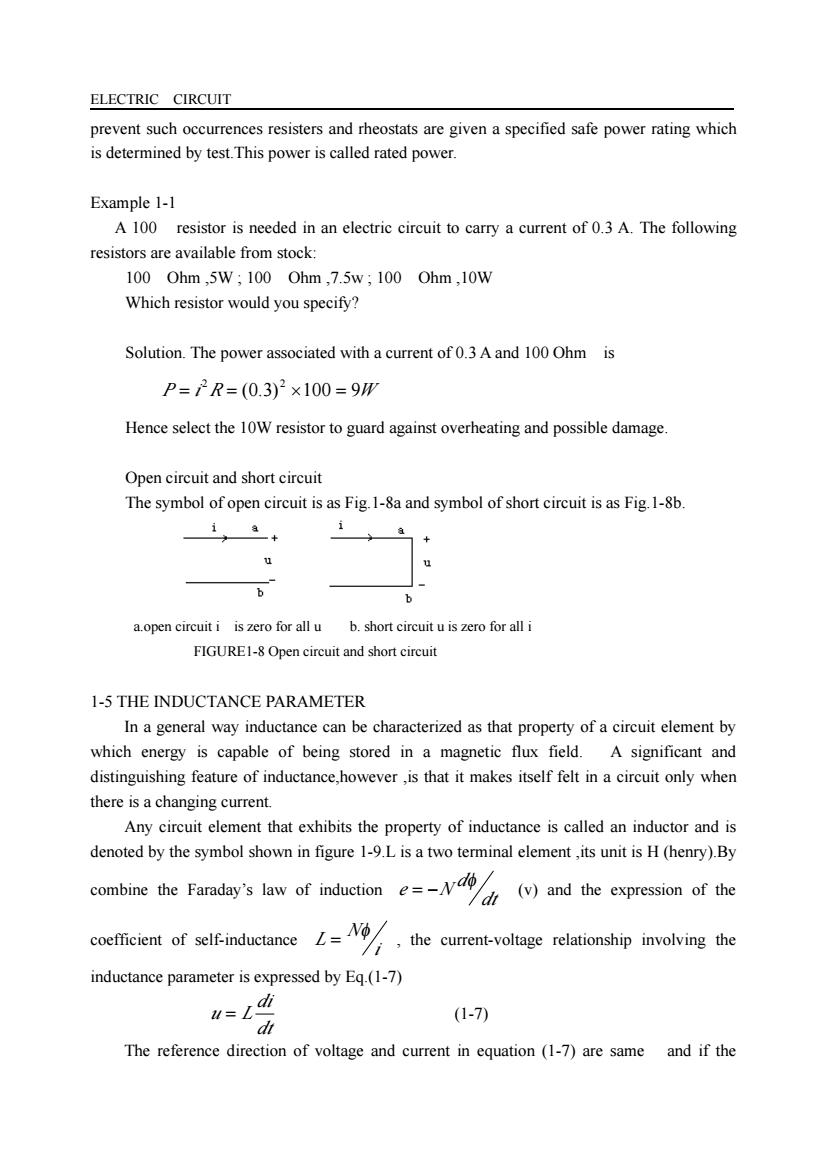
ELECTRIC CIRCUIT prevent such occurrences resisters and rheostats are given a specified safe power rating which is determined by test.This power is called rated power Example 1-1 A 100 resistor is needed in an electric circuit to carry a current of 0.3 A.The following resistors are available from stock: 100Ohm,5w,100Ohm,7.5w;100Ohm,10W Which resistor would you specify? Solution.The power associated with a current of 0.3A and 100 Ohm is P=2R=(0.3)2×100=9m Hence select the 10W resistor to guard against overheating and possible damage. Open circuit and short circuit The symbol of open circuit is as Fig.1-8a and symbol of short circuit is as Fig 1-8b + 31+ a.open circuit i iszero for all u b.short eircuituiszero foralli FIGURE1-8Open circuit and short circuit 1-5 THE INDUCTANCE PARAMETER In a general way inductance can be characterized as that property of a circuit element by which energy is capable of being stored in a magnetic flux field.A significant and distinguishing feature of inductance,however,is that it makes itself felt in a circuit only when there is a changing current. Any circuit element that exhibits the property of inductance is called an inductor and is denoted by the symbol shown in figure 1-9.L is a two terminal element,its unit is H(henry).By combine the Faraday's aw of induction()and the of te coefficient of self-inductance the current-voltage relationship involving the inductance parameter is expressed by Eq.(1-7) (1-7) The reference direction of voltage and current in equation(1-7)are same and if the
ELECTRIC CIRCUIT prevent such occurrences resisters and rheostats are given a specified safe power rating which is determined by test.This power is called rated power. Example 1-1 A 100 resistor is needed in an electric circuit to carry a current of 0.3 A. The following resistors are available from stock: 100 Ohm ,5W ; 100 Ohm ,7.5w ; 100 Ohm ,10W Which resistor would you specify? Solution. The power associated with a current of 0.3 A and 100 Ohm is P i R (0.3) 100 9W 2 2 = = × = Hence select the 10W resistor to guard against overheating and possible damage. Open circuit and short circuit The symbol of open circuit is as Fig.1-8a and symbol of short circuit is as Fig.1-8b. a.open circuit i is zero for all u b. short circuit u is zero for all i FIGURE1-8 Open circuit and short circuit 1-5 THE INDUCTANCE PARAMETER In a general way inductance can be characterized as that property of a circuit element by which energy is capable of being stored in a magnetic flux field. A significant and distinguishing feature of inductance,however ,is that it makes itself felt in a circuit only when there is a changing current. Any circuit element that exhibits the property of inductance is called an inductor and is denoted by the symbol shown in figure 1-9.L is a two terminal element ,its unit is H (henry).By combine the Faraday’s law of induction dt d e N φ = − (v) and the expression of the coefficient of self-inductance i N L φ = , the current-voltage relationship involving the inductance parameter is expressed by Eq.(1-7) dt di u = L (1-7) The reference direction of voltage and current in equation (1-7) are same and if the
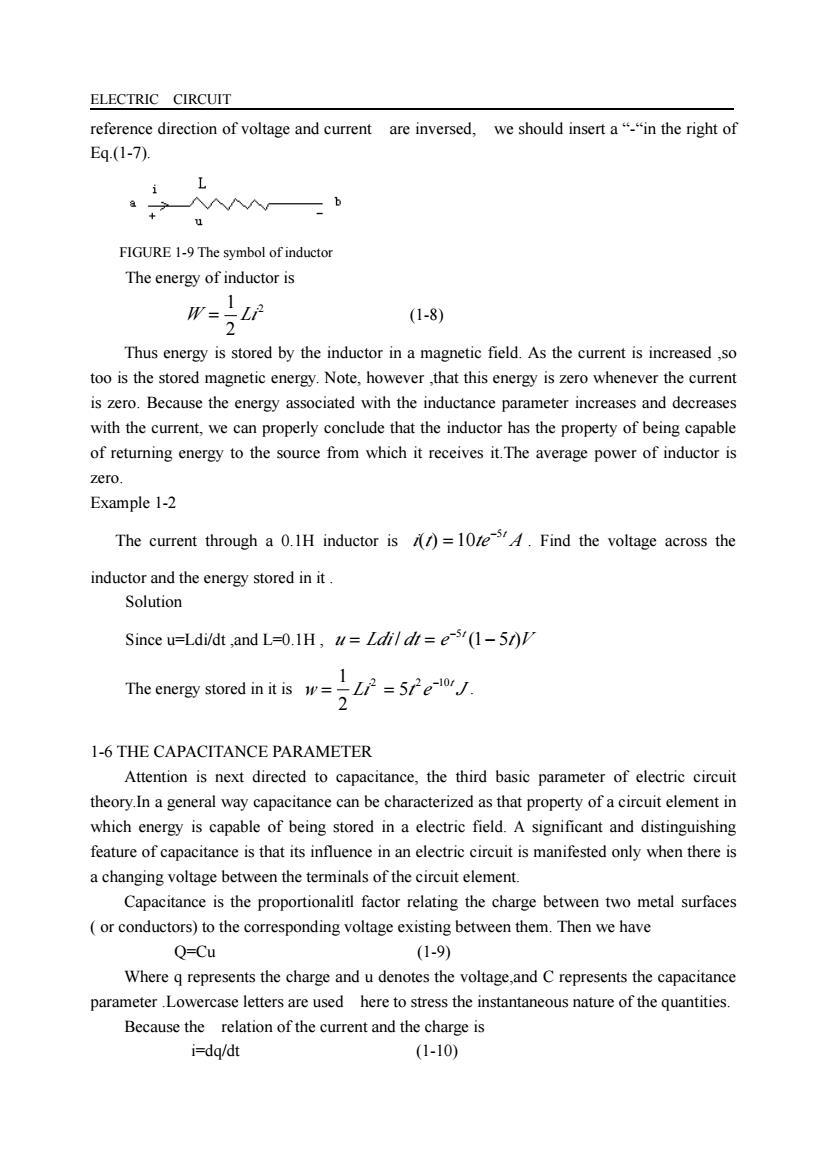
ELECTRIC CIRCUIT reference direction of voltage and current are inversed,we should insert a""in the right of Eq.(1-7. 人 u FIGURE1-9The symbol ofinductor The energy of inductor is (1-8) Thus energy is stored by the inductor in a magnetic field.As the current is increased,so too is the stored magnetic energy.Note,however that this energy is zero whenever the current is zero.Because the energy associated with the inductance parameter increases and decreases with the current,we can properly conclude that the inductor has the property of being capable of returning energy to the source from which it receives it.The average power of inductor is zero. Example 1-2 The current through a 0.IH inductor is )=10/e4.Find the voltage across the inductor and the energy stored in it Solution Since u=Ldildt ,and L=0.1H,u=Ldil dt=e-s'(1-51)/ The energy stored initis 1-6 THE CAPACITANCE PARAMETER Attention is next directed to capacitance,the third basic parameter of electric circuit theory In a general way capacitance can be characterized as that property of a circuit lement in which energy is capable of being stored in a electric field.A significant and distinguishing feature of capacitance is that its influence in an electric circuit is manifested only when there is a changing voltage between the terminals of the circuit element. Capacitance is the proportionalitl factor relating the charge between two metal surfaces or conductors)to the corresponding voltage existing between them.Then we have Q=Cu (1-9) Where q represents the charge and u denotes the voltage,and C represents the capacitance parameter Lowercase letters are used here to stress the instantaneous nature of the quantities. Because the relation of the current and the charge is i=dq/dt (1-10)
ELECTRIC CIRCUIT reference direction of voltage and current are inversed, we should insert a “-“in the right of Eq.(1-7). FIGURE 1-9 The symbol of inductor The energy of inductor is 2 2 1 W = Li (1-8) Thus energy is stored by the inductor in a magnetic field. As the current is increased ,so too is the stored magnetic energy. Note, however ,that this energy is zero whenever the current is zero. Because the energy associated with the inductance parameter increases and decreases with the current, we can properly conclude that the inductor has the property of being capable of returning energy to the source from which it receives it.The average power of inductor is zero. Example 1-2 The current through a 0.1H inductor is i t te A5t ( ) 10 − = . Find the voltage across the inductor and the energy stored in it . Solution Since u=Ldi/dt ,and L=0.1H , u Ldi dt e t V t / (1 5 ) 5 = = − − The energy stored in it is w Li t e J 2 2 10t 5 2 1 − = = . 1-6 THE CAPACITANCE PARAMETER Attention is next directed to capacitance, the third basic parameter of electric circuit theory.In a general way capacitance can be characterized as that property of a circuit element in which energy is capable of being stored in a electric field. A significant and distinguishing feature of capacitance is that its influence in an electric circuit is manifested only when there is a changing voltage between the terminals of the circuit element. Capacitance is the proportionalitl factor relating the charge between two metal surfaces ( or conductors) to the corresponding voltage existing between them. Then we have Q=Cu (1-9) Where q represents the charge and u denotes the voltage,and C represents the capacitance parameter .Lowercase letters are used here to stress the instantaneous nature of the quantities. Because the relation of the current and the charge is i=dq/dt (1-10)
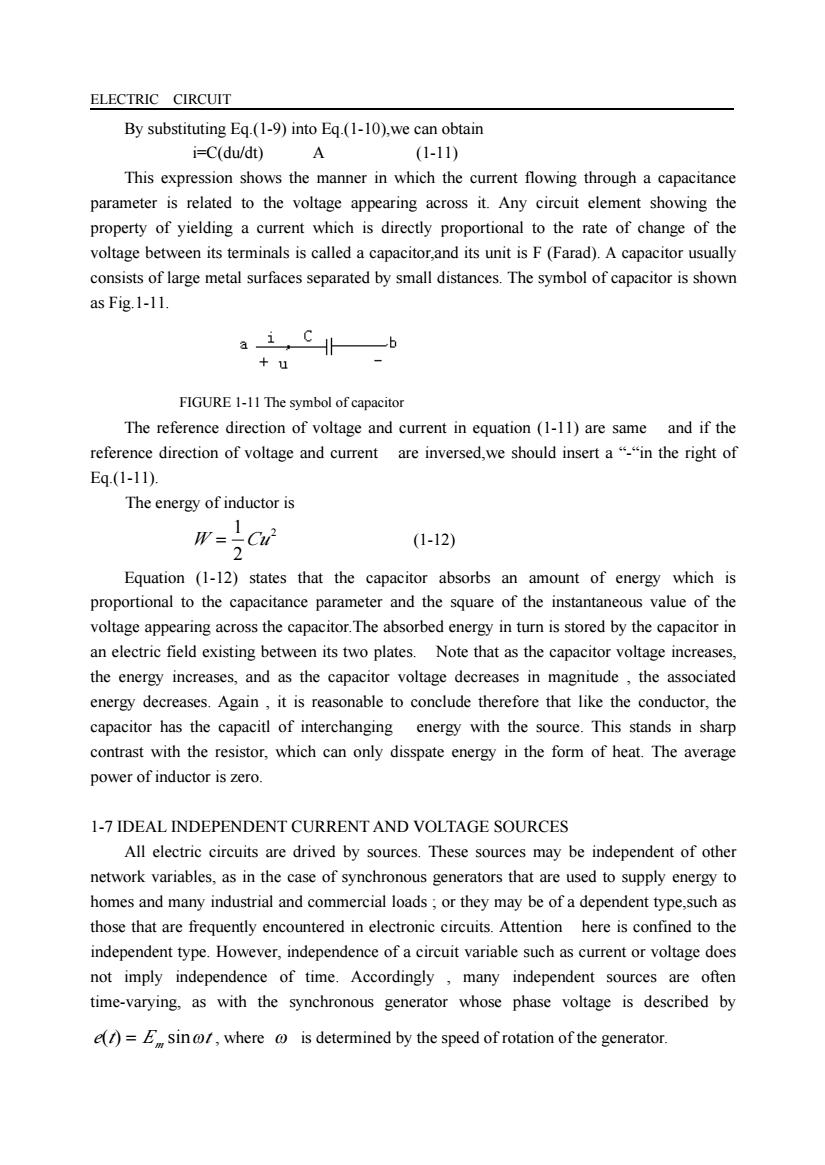
ELECTRIC CIRCUIT By substituting Eq.(1-9)into Eq.(1-10),we can obtain i=C(du/dt) (1-11) This expression shows the manner in which the current flowing through a capacitance parameter is related to the voltage appearing across it.Any circuit element showing the property of yielding a current which is directly proportional to the rate of change of the voltage between its terminals is called a capacitor,and its unit is F(Farad).A capacitor usually consists of large metal surfaces separated by small distances.The symbol of capacitor is shown as Fig.1-11. +u FIGURE 1-11The symbol of capacitor The reference direction of voltage and current in equation (1-11)are same and if the reference direction of voltage and current are inversed,we should insert a"in the right of Eq.(1-11) The energy of inductor is W-TOi (1-12) Equation (1-12)states that the capacitor absorbs an amount of energy which is proportional to the capacitance parameter and the square of the instantaneous value of the voltage appearing across the capacitor.The absorbed energy in turn is stored by the capacitor in an electric field existing between its two plates.Note that as the capacitor voltage increases. the energy increases,and as the capacitor voltage decreases in magnitude,the associated energy decreases.Again,it is reasonable to conclude therefore that like the conductor,the capacitor has the capacitl of interchanging energy with the source.This stands in sharp contrast with the resistor,which can only disspate energy in the form of heat.The average power of inductor is zero. 1-7 IDEAL INDEPENDENT CURRENT AND VOLTAGE SOURCES All electric circuits are drived by sources.These sources may be independent of other network variables.as in the case of synchronous generators that are used to supply energy to homes and many industrial and commercial loads;or they may be of a dependent type,such as those that are frequently encountered in electronic circuits.Attention here is confined to the independent type.However,independence of a circuit variable such as current or voltage does not imply independence of time.Accordingly,many independent sources are often time-varying,as with the synchronous generator whose phase voltage is described by )=Esin/,where is determined by the speed of rotation of the generator
ELECTRIC CIRCUIT By substituting Eq.(1-9) into Eq.(1-10),we can obtain i=C(du/dt) A (1-11) This expression shows the manner in which the current flowing through a capacitance parameter is related to the voltage appearing across it. Any circuit element showing the property of yielding a current which is directly proportional to the rate of change of the voltage between its terminals is called a capacitor,and its unit is F (Farad). A capacitor usually consists of large metal surfaces separated by small distances. The symbol of capacitor is shown as Fig.1-11. FIGURE 1-11 The symbol of capacitor The reference direction of voltage and current in equation (1-11) are same and if the reference direction of voltage and current are inversed,we should insert a “-“in the right of Eq.(1-11). The energy of inductor is 2 2 1 W = Cu (1-12) Equation (1-12) states that the capacitor absorbs an amount of energy which is proportional to the capacitance parameter and the square of the instantaneous value of the voltage appearing across the capacitor.The absorbed energy in turn is stored by the capacitor in an electric field existing between its two plates. Note that as the capacitor voltage increases, the energy increases, and as the capacitor voltage decreases in magnitude , the associated energy decreases. Again , it is reasonable to conclude therefore that like the conductor, the capacitor has the capacitl of interchanging energy with the source. This stands in sharp contrast with the resistor, which can only disspate energy in the form of heat. The average power of inductor is zero. 1-7 IDEAL INDEPENDENT CURRENT AND VOLTAGE SOURCES All electric circuits are drived by sources. These sources may be independent of other network variables, as in the case of synchronous generators that are used to supply energy to homes and many industrial and commercial loads ; or they may be of a dependent type,such as those that are frequently encountered in electronic circuits. Attention here is confined to the independent type. However, independence of a circuit variable such as current or voltage does not imply independence of time. Accordingly , many independent sources are often time-varying, as with the synchronous generator whose phase voltage is described by e t E t ( ) = m sinω , where ω is determined by the speed of rotation of the generator
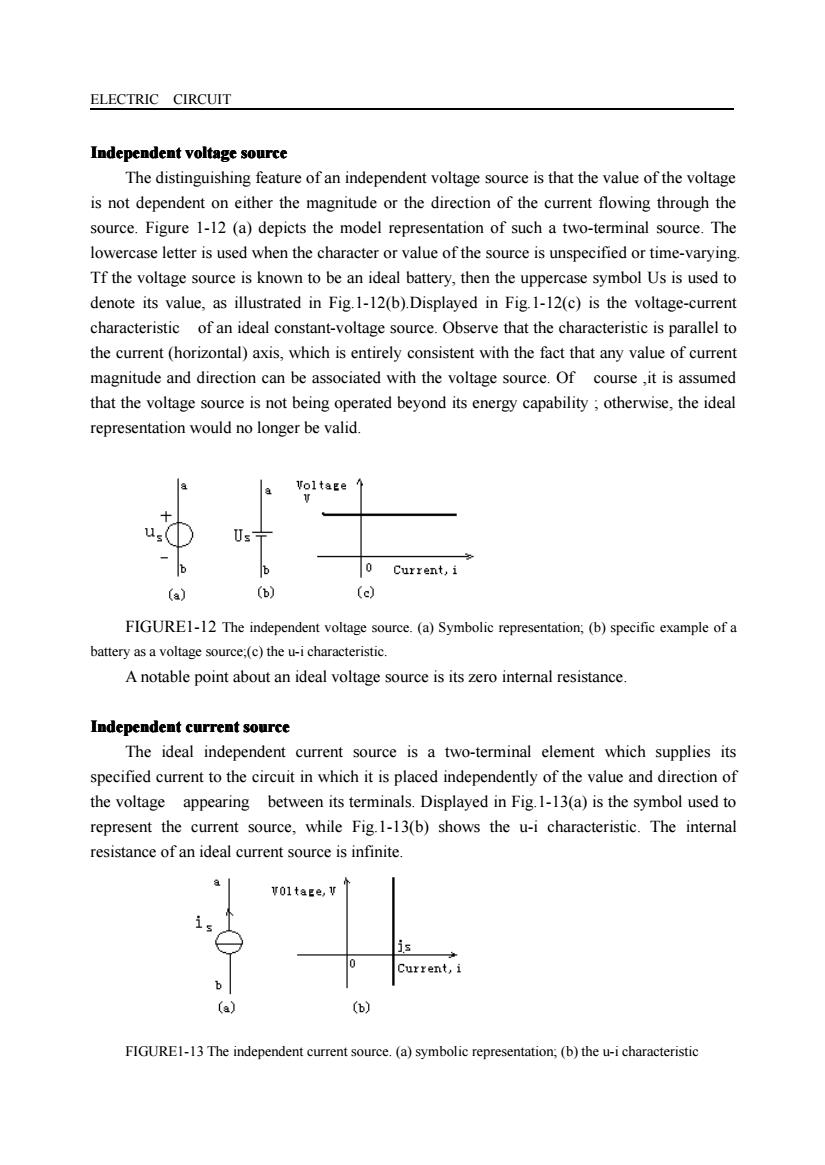
ELECTRIC CIRCUIT Independent voltage source The distinguishing feature of an independent voltage source is that the value of the voltage is not dependent on either the magnitude or the direction of the current flowing through the source.Figure 1-12(a)depicts the model representation of such a two-terminal source.The lowercase letter is used when the character or value of the source is unspecified or time-varying Tf the voltage source is known to be an ideal battery,then the uppercase symbol Us is used to denote its value,as illustrated in Fig.1-12(b).Displayed in Fig 1-12(c)is the voltage-current characteristic of an ideal constant-voltage source.Observe that the characteristic is parallel to the current(horizontal)axis,which is entirely consistent with the fact that any value of current magnitude and direction can be associated with the voltage source.Of course,it is assumed that the voltage source is not being operated beyond its energy capability;otherwise,the ideal representation would no longer be valid. Us 0 Current,i (a) (b) ( FIGURE1-12 The independent voltage source.(a)Symbolic representation;(b)specific example of a battery as a voltage source(c)the u-icharacteristic. A notable point about an ideal voltage source is its zero internal resistance Independent current source The ideal independent current source is a two-terminal element which supplies its specified current to the circuit in which it is placed independently of the value and direction of the voltage appearing between its terminals.Displayed in Fig 1-13(a)is the symbol used to represent the current source,while Fig.1-13(b)shows the u-i characteristic.The internal resistance of an ideal current source is infinite. 01tage, Current,i (a) (b) FIGURE1-13The indepe (a) tion,(b)the u-icharacteristic
ELECTRIC CIRCUIT Independent Independent Independent Independent voltage voltage voltage voltage source The distinguishing feature of an independent voltage source is that the value of the voltage is not dependent on either the magnitude or the direction of the current flowing through the source. Figure 1-12 (a) depicts the model representation of such a two-terminal source. The lowercase letter is used when the character or value of the source is unspecified or time-varying. Tf the voltage source is known to be an ideal battery, then the uppercase symbol Us is used to denote its value, as illustrated in Fig.1-12(b).Displayed in Fig.1-12(c) is the voltage-current characteristic of an ideal constant-voltage source. Observe that the characteristic is parallel to the current (horizontal) axis, which is entirely consistent with the fact that any value of current magnitude and direction can be associated with the voltage source. Of course ,it is assumed that the voltage source is not being operated beyond its energy capability ; otherwise, the ideal representation would no longer be valid. FIGURE1-12 The independent voltage source. (a) Symbolic representation; (b) specific example of a battery as a voltage source;(c) the u-i characteristic. A notable point about an ideal voltage source is its zero internal resistance. Independent Independent Independent Independent current current current current source The ideal independent current source is a two-terminal element which supplies its specified current to the circuit in which it is placed independently of the value and direction of the voltage appearing between its terminals. Displayed in Fig.1-13(a) is the symbol used to represent the current source, while Fig.1-13(b) shows the u-i characteristic. The internal resistance of an ideal current source is infinite. FIGURE1-13 The independent current source. (a) symbolic representation; (b) the u-i characteristic
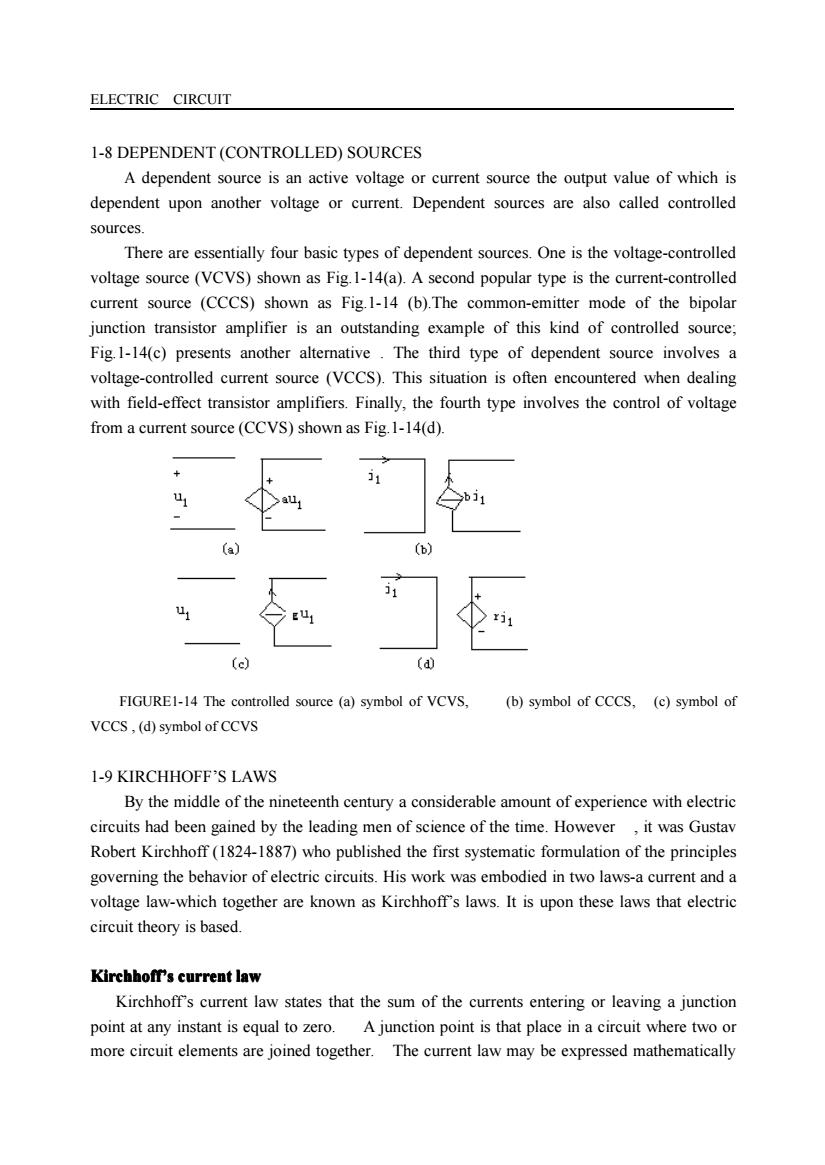
ELECTRIC CIRCUIT L-8 DEPENDENT (CONTROLLEDI SOURCES A dependent source is an active voltage or current source the output value of which is dependent upon another voltage or current.Dependent sources are also called controlled sources. There are essentially four basic types of dependent sources.One is the voltage-controlled voltage source (VCVS)shown as Fig.1-14(a).A second popular type is the current-controlled current source (CCCS)shown as Fig.1-14 (b).The common-emitter mode of the bipolar junction transistor amplifier is an outstanding example of this kind of controlled source; Fig.1-14(c)presents another alterative.The third type of dependent source involves a voltage-controlled current source (VCCS).This situation is often encountered when dealing with field-effect transistor amplifiers.Finally,the fourth type involves the control of voltage from a current source(CCVS)shown as Fig.1-14(d). (b) (e) FIGURE1-14 The controlled source (a)symbol of VCVS, (b)symbol of CCCS,(c)symbol of VCCS,(d)symbol of CCVS 19 KIRCHHOFF'S LAWS By the middle of the nineteenth century a considerable amount of experience with electric circuits had been gained by the leading men of science of the time.However it was Gustav Robert Kirchhoff(1824-1887)who published the first systematic formulation of the principles governing the behavior of electric circuits.His work was embodied in two laws-a current and a voltage law-which together are known as Kirchhoff's laws.It is upon these laws that electric circuit theory is based Kirchhoff's current law Kirchhoff's current law states that the sum of the currents entering or leaving a junction point at any instant is equal to zero. A junction point is that place in a circuit where two o more circuit elements are joined together.The current law may be expressed mathematically
ELECTRIC CIRCUIT 1-8 DEPENDENT (CONTROLLED) SOURCES A dependent source is an active voltage or current source the output value of which is dependent upon another voltage or current. Dependent sources are also called controlled sources. There are essentially four basic types of dependent sources. One is the voltage-controlled voltage source (VCVS) shown as Fig.1-14(a). A second popular type is the current-controlled current source (CCCS) shown as Fig.1-14 (b).The common-emitter mode of the bipolar junction transistor amplifier is an outstanding example of this kind of controlled source; Fig.1-14(c) presents another alternative . The third type of dependent source involves a voltage-controlled current source (VCCS). This situation is often encountered when dealing with field-effect transistor amplifiers. Finally, the fourth type involves the control of voltage from a current source (CCVS) shown as Fig.1-14(d). FIGURE1-14 The controlled source (a) symbol of VCVS, (b) symbol of CCCS, (c) symbol of VCCS , (d) symbol of CCVS 1-9 KIRCHHOFF’S LAWS By the middle of the nineteenth century a considerable amount of experience with electric circuits had been gained by the leading men of science of the time. However , it was Gustav Robert Kirchhoff (1824-1887) who published the first systematic formulation of the principles governing the behavior of electric circuits. His work was embodied in two laws-a current and a voltage law-which together are known as Kirchhoff’s laws. It is upon these laws that electric circuit theory is based. Kirchhoff Kirchhoff Kirchhoff Kirchhoff’s current current current current law Kirchhoff’s current law states that the sum of the currents entering or leaving a junction point at any instant is equal to zero. A junction point is that place in a circuit where two or more circuit elements are joined together. The current law may be expressed mathematically

ELECTRIC CIRCUIT as ,=0 (1-13) The current law is nothing more than a restatement of the principle of conservation of charge. For the circuit of Figl-16 there are five circuit elements joined at node n-fore passive elements (the resistors )and one active element (the battery).Applying Eq.(1-13)to node n we have -/+/-12+/3+/4=0 The minus signs are used because these current are defined as entering the node.This equation can be rewritten as 1,+=I+3+14 This equation states in mathematical terms that the sum of the current entering the node is equal to the sum of the currents leaving it. R R R Figure 1-15 Illustrating Kirchhoff's current law To the closed plane -generalized node Kirchhoff's current law is also valid.For the circuit of Figl-16 there are three circuit elements joined at the generalized nodeApplying Eq.(1-13)to it we have 1-5+5=0 Figure 1-16 KCLof generalized node Kirchhoff's voltage law Kirchhoff's voltage law states that at any time instant the sum of voltages in a closed circuit is zero.Essentially this law is a restatement of the law of conservation of energy.A generalized formulation of Kirchhoffs current law is
ELECTRIC CIRCUIT as 0 1 ∑ = = k j j i (1-13) The current law is nothing more than a restatement of the principle of conservation of charge. For the circuit of Fig1-16 there are five circuit elements joined at node n—fore passive elements (the resistors ) and one active element (the battery). Applying Eq.(1-13) to node n we have − I 5 + I 1 − I 2 + I 3 + I 4 = 0 The minus signs are used because these current are defined as entering the node. This equation can be rewritten as 5 2 1 3 4 I + I = I + I + I This equation states in mathematical terms that the sum of the current entering the node is equal to the sum of the currents leaving it. Figure 1-15 Illustrating Kirchhoff’s current law To the closed plane –generalized node , Kirchhoff’s current law is also valid. For the circuit of Fig1-16 there are three circuit elements joined at the generalized node .Applying Eq.(1-13) to it we have i1 − i 2 + i3 = 0 Figure 1-16 KCL of generalized node Kirchhoff Kirchhoff Kirchhoff Kirchhoff’s voltage voltage voltage voltage law Kirchhoff’s voltage law states that at any time instant the sum of voltages in a closed circuit is zero. Essentially this law is a restatement of the law of conservation of energy. A generalized formulation of Kirchhoff’s current law is